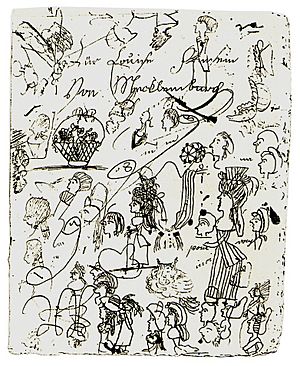Doodle facts for kids

A doodle is a simple drawing you make when your mind is busy with something else. Doodles can be pictures of real things, or they can just be random, abstract lines. Often, you don't even lift your pen or pencil from the paper when you doodle. If it's just random lines, it's sometimes called a "scribble."
You might think of young kids and toddlers scribbling. This is because their hand–eye coordination is still developing. But adults doodle too, often when they are bored or just having fun.
Where do you usually see doodles? Many students draw them in the margins of their school notebooks. This often happens when they are daydreaming or not paying full attention in class. People also doodle during long telephone calls if they have a pen and paper nearby.
What do people doodle? Common doodles include cartoon versions of teachers or friends. You might also see famous TV or comic characters, made-up creatures, or even landscapes. Some doodles are just geometric shapes, patterns, or textures. Many people tend to draw the same kinds of doodles over and over again throughout their lives.
Contents
What Does "Doodle" Mean?
The word doodle first appeared a long time ago, in the early 1600s. Back then, it meant a silly person or a simpleton. It might have come from German words like Dudeltopf, which also meant a simple person.
Later, in the 1700s, the verb "to doodle" meant to trick someone or make a fool of them. The modern meaning of doodling, as in drawing aimlessly, came from a different idea. It was used to describe a politician who wasn't doing anything useful in their job. This led to the general meaning of "to doodle" as doing nothing important.
The old meaning of "fool" is still found in the song title "Yankee Doodle." This song was first sung by British soldiers during the American Revolutionary War.
How Doodling Helps Your Memory
Did you know doodling can actually help you remember things? A study in the Applied Cognitive Psychology journal found this out. Doodling uses just enough brain power to stop you from completely daydreaming. Daydreaming can take up a lot of your brain's focus.
So, doodling helps you stay in the middle ground: not thinking too much, but also not thinking too little. It helps you focus on what's happening right now. Professor Jackie Andrade from the University of Plymouth led this study. She found that people who doodled remembered about 7.5 pieces of information out of 16. This was 29% more than the non-doodlers, who remembered only 5.8 pieces.
Doodling also helps you understand new information better. When you draw pictures of what you're learning, it helps your brain process the information more deeply. It's like your brain uses special pathways to sort and understand things. Because of this, doodling can be a great study tool and a way to boost your memory.
Doodling for Stress Relief
Doodling can be a good way to calm down and reduce stress. It's a bit like other small movements people make, such as fidgeting or pacing, when they feel stressed. A survey of over 9,000 doodles showed that almost two-thirds of people said they doodled when they felt "tense or restless." They did it to feel better.
Scientists think doodling helps with stress because of how it uses a part of your brain called the default mode network. Doodling is often used in art therapy. It helps people slow down, focus, and relax.
Famous Doodlers
Many famous people have been known to doodle. For example, the Russian writer Alexander Pushkin filled his notebooks with doodles. He drew sketches of his friends, hands, and feet in the margins. These notebooks are now seen as works of art themselves. Some of Pushkin's doodles were even made into an animated film called My Favorite Time.
Other well-known doodlers include:
- The writer Samuel Beckett.
- The poet and doctor John Keats, who doodled in his medical notes.
- The poet Sylvia Plath.
- The Nobel Prize winner Rabindranath Tagore, who made many doodles in his writings.
The mathematician Stanislaw Ulam created the Ulam spiral while doodling. He was at a boring math conference and drew this spiral to visualize prime numbers.
Many American Presidents have also been known to doodle during meetings. This includes Thomas Jefferson, Ronald Reagan, and Bill Clinton. Even Leonardo da Vinci, the famous artist and inventor, had doodles and drawings in his notebooks.
See also
 In Spanish: Garabato (dibujo) para niños
In Spanish: Garabato (dibujo) para niños


